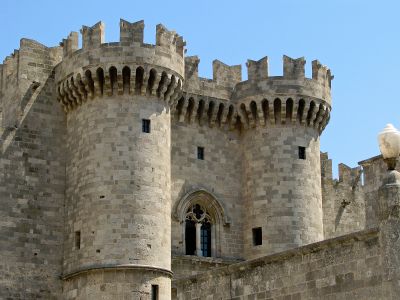Aegean Castles
A castles in the heart of the Aegean
From the Mesolithic Age, the Aegean Islands ceased to be an obstacle and became a bridge joining the inhabitants of the region. Shipping, trade, economy, culture and social interactions developed in the archipelago and surrounding areas on the basis of communication and contact between the inhabitants. This was especially true after the permanent settlement of the islands 5000 years BC.
A brief introduction to the Aegean Islands
The islands were conquered by the Persians in the Greco-Persian Wars in the 5th century BC. After their release in 468 BC they made an alliance with Athens. However, during the Peloponnesian War (429-404 BC ) their allegiance swayed between Athens and Sparta. In 338 BC the Macedonians came into power followed by Ptolemaic Egypt. After this period the islands suffered the same fate as the rest of Greece by becoming the province of the Roman Empire. During the Byzantine era there is calm in the North Aegean, but from the 7th century on this was disrupted by Arab raids.
After the conquest of Constantinople by the Franks in 1204 the islands find themselves shared amongst the Venetians, Genoese and Frank princes (Frankokratia). Under this rule shipping and trade flourished. The fall of Constantinople in 1453 and the founding of the Ottoman Empire resulted in a period of destruction, plundering and persecution for the islands. The occupation also led to the decline of the Christian population. In the early 16th century the islands began to enjoy a period of prosperity.
The hostile aspirations of the raiders, especially the pirates, led to many settlements in a fortification organization. The outer houses are next to each other to form a wall leaving minimal entrances to the interior. The streets of the villages are full of surprises, dead ends, width variations, unexpected sight openings.
“Greece left me breathless! . . .” Leonardo Di Caprio
Fortification settlements around the castles
With a Venetian or Frankish castle center, the settlements grow peripherally in rings, with houses joined together to create a second wall that can protect them from simple pirates attacks.
Examples of such settlements are found in Astypalea, Patmos, Molyvos, Mytilini, Amorgos, Lindos, Rhodes, Skyros.
The defensive system of the fortifications is based on the stifling construction, with the houses next to each other creating the same firewall. The entrance to the settlement is made of large gates, which, in a period of danger, ensure protection. Such settlement is of Serifos, the Castle of Sifnos and Ano Syra. The castle of Naxos Town is one of the rare cases where an engineering design accurately determined the relation of the wall with the mansions and the houses, so that a fortified settlement could be created by them to establish the Venetian Duchy, the seat of all the Cyclades. The work of the first governor of the Duchy, Markos Sanoudos (1207), the castle, built on temple ruins, protected the Venetian colony from the pirates, raiders and the hostility of the locals.


